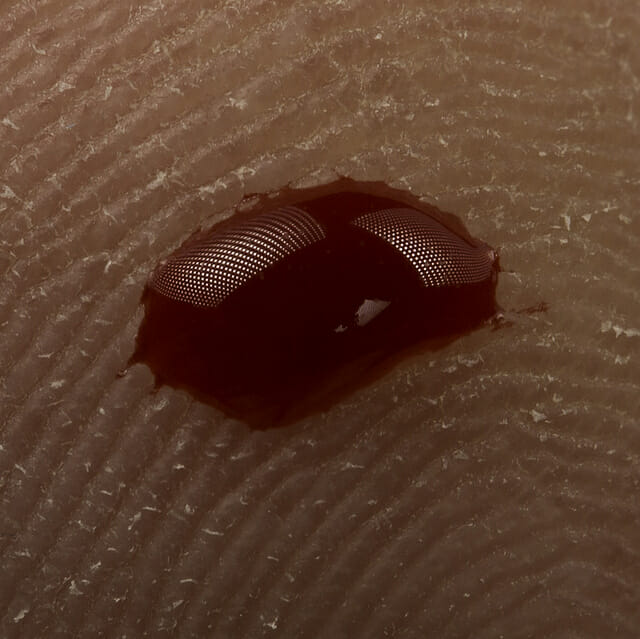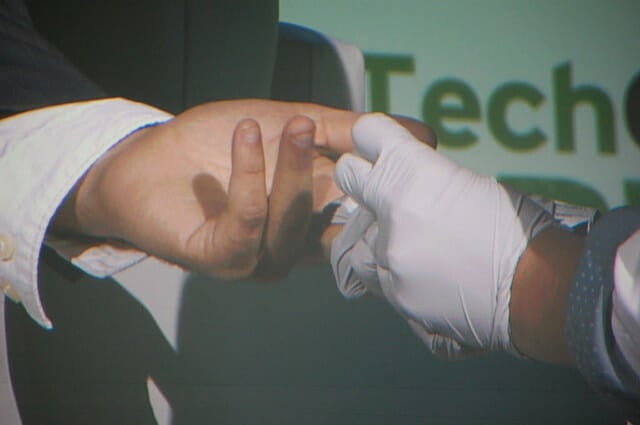Blood Will Out
Theranos and the Shark Tankification of American Life Alden Chadwick
Alden Chadwick o
r
d
F
a
c
t
o
r
y
Those who didn’t go out of their way to follow the story of Theranos, the ambitious blood-testing company founded by Elizabeth Holmes when she dropped out of Stanford at age nineteen, will likely remember two moments when the company burst into national media attention. The first was in 2014, when Holmes appeared on the covers of Forbesand Fortuneand was declared to be “the youngest woman to become a self-made billionaire”—her company had been valued at $9 billion earlier that year. Theranos promised to create a device that would test for hundreds of diseases and health markers from a single drop of blood; Holmes called it “the iPod of healthcare” and envisioned a day when the device would be in every home. Her vision sounded grand. “We see a world in which no one ever has to say, ‘If only I’d known sooner,’” she told a TEDMED audience, “A world in which no one ever has to say goodbye too soon.” It was a great idea. One wanted to believe it.
The second wave of publicity came just about one year later, when Theranos’s whole operation was exposed, its promises shown to be based on exaggerations and outright lies, many in the form of faked or massaged data about the accuracy of the blood-testing device. In March of this year, the SEC charged Theranos, Holmes, and her boyfriend and second-in-command Sunny Balwani with conducting “an elaborate, years-long fraud.”
John Carreyrou’s Bad Bloodfills in the gaps leading up to and in between these moments. The story of Theranos is the story of the Shark Tankification of American life, in which “optics” and “pitching”—rather than actual achievement—are the wellsprings from which success (or at least venture capital) flows.
“Optics” and “pitching”—rather than actual achievement—are the wellsprings from which success (or at least venture capital) flows.
Holmes founded Theranos at nineteen and dropped out of Stanford to run the company; from the beginning, she “demanded absolute loyalty from her employees” and dealt swiftly with anyone who questioned the technology or her management. Carreyrou details several “purges” and attempted “coups” within Theranos’s ranks, which came about when employees noticed that the data didn’t add up or that the machines didn’t function as they were supposed to. While the devices were being developed and tested, demonstrations of the devices for potential partners and investors were faked; Balwani had a software engineer write an application for one Theranos device to cover up malfunctions—when a test couldn’t be completed, the screen would just show a very slow progress bar instead of admitting an error. None of this stopped Holmes from regarding herself as a kind of prophetic figure who was going to change the world. When Holmes arranged a partnership with Walgreens that would put the dicey devices into pharmacies where they would be used on actual patients, one engineer told Holmes directly that the error rate was far too high and they should wait to launch. Holmes refused to delay the launch and the engineer quit. The next day, Holmes held an all-staff meeting where she distributed copies of Paulho Coehlo’s book The Alchemist, told her employees she was building a religion, and said that any nonbelievers should “get the fuck out.”
More

The Fabled and Enabled
By Chris LehmannAt a moment when fraud and misdirection are so thoroughly integrated into American public life at the highest levels, this story is surprising only because it took place within the sphere of medicine—or, more precisely, “biotech”—an area of life guarded by the high stone walls of the FDA, institutional review boards and the Hippocratic oath.
Holmes skirts all of these. One of her strategies was specifically to pretend to be pro-regulation, making public statements and even writing an op-ed in the Wall Street Journalsupporting the FDA’s drive for regular laboratory-developed tests. Meanwhile, Theranos “operated in a regulatory no-man’s land.” Because it used its machines only within its own lab and did not try to commercialize them, the company avoided FDA scrutiny. When one regulatory agency sent inspectors to look at Theranos’s lab, Holmes offered a tour of one, but physically hid the other, locking a door in front of the lab and prohibiting employees from entering, so that inspectors wouldn’t know it was there.
Carreyrou’s book is masterfully reported. In the first half, he includes a few anecdotes about Holmes’s youth. (In the opening scene, a relative asks a young Holmes what she wants to be when she grows up. “Without skipping a beat,” Carreyrou writes, she replied, “I want to be a millionaire.”) But the bulk of this part of the book is dedicated to documenting the formation of the company from 2009 through 2014. In this telling, employee after employee informs Holmes of technical problems and oversights, only to be railroaded, fired, or simply brushed off. Reading this portion of the book, it’s easy to imagine that Carreyrou’s sources flowed to him en masse as things fell apart, eager to tell the world that they weren’t the ones who had done wrong, that they saw what was happening and tried, without whatever degree of success, to intervene.
The book swerves, and becomes an entirely different, and more exciting, kind of story, when Carreyrou enters the action himself. In 2014, when Holmes and Theranos were being widely (and credulously) lauded in the press, Carreyrou received a message from a pathology blogger who was following the reports and called bullshit on the claims being made about Theranos’s technology. What follows is a ripping good yarn about how Carreyrou and his sources navigated a web of surveillance and legal intimidation. Here we see what feats of reporting and whistleblowing went into gathering the facts that are laid out so casually in the previous chapters. It’s a bit like if Spotlightwere recast in Silicon Valley.
Holmes is aware that Carreyrou is investigating, and has some idea of who his sources are. As the day of reckoning starts to seem inevitable, she ramps up her information wars. When Carreyrou’s first exposé is published, Holmes complains that the coverage is sexist. The press is referring to her in every critical story as a young woman. “Have you ever heard someone call Mark Zuckerberg ‘young man’?” she asks the audience at one public interview. (A hilarious example because coverage of the mid-thirties Zuckerberg still routinely treats him as an ingenue.) Months after the media reports started to unravel Theranos’s cover-ups, she appeared at a chemistry conference to demonstrate the company’s improved technology, which turned out to be lackluster. One pathology professor in attendance said her presentation had “the feel of someone putting together a last-minute term paper late at night.” A straightforward heckler in the audience, at the end of her presentation, put it succinctly: “You hurt people.”
Holmes’s boyfriend, Balwani, a man who drives a Porsche with the Marx-trolling vanity license plate DAZKPTL, is constantly screaming at and firing people.
The heckler is a good reminder of what Holmes goal was: to put her machines into homes and healthcare settings across the country, whether they worked or not. So much of the struggle detailed in Bad Bloodhappens inside the company: what’s at stake is whether an employee will be dressed down or fired, whether their bosses will treat them with hostility, whether a warning message will be heard by the members of the board (a board, by the way, populated with a long list of war-makers including Henry Kissinger, Sam Nunn, Jim Mattis, and William Perry). The stories and details from within the firm provide plenty of entertainment and narrative energy. Holmes’s boyfriend, Balwani, a man who drives a Porsche with the Marx-trolling vanity license plate DAZKPTL, is constantly screaming at and firing people. Holmes’s antics are a noxious hybrid of cut-throat, megalomaniacal, and cornily inspirational; she outfits her office like a replica of the Oval Office, complete with bullet-proof glass; she badly paraphrased Gandhi quotations; a sign on her desk asks what you would do if you knew you could not fail. The inside of Theranos is so strange and engrossing that it’s easy to forget the other people involved in the story—the patients who had blood work performed on the firm’s unreliable machines, and the many, many more who would have. When the pathology blogger reached out to Carreyrou and the truth started to unravel, Theranos was “expanding its blood testing service to Walgreens 8,134 other U.S. stores.”
As Theranos’s story wraps up (in the book at least; in real life it’s still very much unfolding, with future criminal charges a possibility), my mind turned to the ambitious nineteen-year-old Elizabeth Holmes, and to the basic idea of her company. A portable blood-testing machine that was small enough to install in a local pharmacy or a home. A wide battery of tests from a single finger prick instead of a large draw of venous blood. It is a good and useful idea. And I wonder if Theranos might have fulfilled its promise—in some form. There’s nothing wrong with a grand dream, of course, of the imagining of a giant idea. But anyone who actually makes things knows: there’s a gap between the imaginary and the real. That’s where the work happens. To pretend otherwise is childish; to pretend otherwise when you’re dealing with people’s health is reckless. If Holmes had allowed the company to drop some of the sexier and more impossible parts of her plan, if the company had built a machine that, yes, still relied on a venous blood draw, or focused on a narrower band of tests, or simply allowed for the many years of plodding engineering work and adjustments necessary to perfect such an ambitious new technology—could it have worked? We don’t know, because Holmes had to be a “unicorn,” something impossibly glamorous whose only flaw is not being real.
















